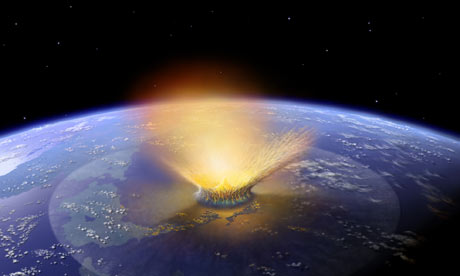
Computer generated simulation of an asteroid strike on the earth 150m years ago.
Photograph: Don Davis/AFP/Getty Images
Photograph: Don Davis/AFP/Getty Images
The head of the Russian space agency said today that it was considering a Hollywood-style mission to send a spacecraft to bump a large asteroid from a possible
Anatoly Perminov told the Russian radio station Golos Rossii: "People's lives are at stake. We should pay several hundred million dollars and build a system that would allow us to prevent a collision, rather than sit and wait for it to happen and kill hundreds of thousands of people."
The mission would be aimed at an asteroid called
The
But the creation of a system to deflect asteroids has long been the subject of scientific debate. Some experts have proposed sending a probe to circle around a dangerous asteroid and gradually change its trajectory. Others suggested sending a spacecraft to collide with it and alter its momentum, or using
Perminov said details of the project still needed to be worked out. But he said the agency would invite Nasa, the
When Apophis was discovered in 2004, astronomers made headlines when they said there was a one in 37 chance that the 350-metre-wide rock would collide with Earth in 2029. Further studies ruled out such an impact, but there remains a one in 250,000 chance it could strike in 2036.
Perminov said he had heard from a scientist that Apophis is getting closer and may hit the planet. "I don't remember exactly, but it seems to me it could hit the Earth by 2032," he said.
Nasa has estimated that if the asteroid hit the Earth, it would release more than 100,000 times the energy released in the nuclear blast over Hiroshima. Thousands of square miles would be directly affected by the blast but the whole of the Earth would see the effects of the dust released into the atmosphere.
Nasa experts have already discussed the option of landing an astronaut on an asteroid to test whether it could develop techniques to deflect a doomsday rock.
Breaking it up with an atomic warhead could generate thousands of smaller objects on a similar course, which could have time to re-form. Scientists agree the best approach, given enough time, would be to nudge the object into a safer orbit.
Matt Genge, a space researcher at
Perminov said: "We will soon hold a closed meeting of our collegium, the science-technical council, to look at what can be done. "There won't be any nuclear explosions. Everything will be done according to the
Mirrors, lights and even paint could change the way the object absorbed light and heat enough to shift its direction over 20 years or so. With less notice, mankind could be forced to take more drastic measures, such as setting off a massive explosion on or near the object to change its course.
Source









0 comments:
Post a Comment
Thank you very much for your opinion